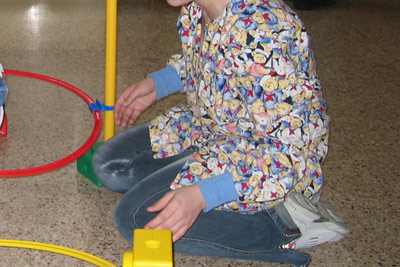ARTICLES
Active Play
MOVING TO LEARNUP, UP AND AWAY!
Getting Ready for Parachute Play
UP, UP AND AWAY!
Getting Set for Parachute Play
Circle Time
DON'T SIT LIKE A WSUCCESSFUL CIRCLE TIME
Policing Leadership
BE A HERO OR BE A HEADLINEDON'T SIT LIKE A W
Helpful information to prevent injuries in kids.by Sharron Krull

Download Article
*Download a printable PDF
"Still sitting between his legs. Attempt to break his sitting habits." This notation on a student's medical record
jumped out at me. I knew just what the doctor meant. Many of my kindergartners sat between their legs,
their knees turned in and their feet out to their sides, looking for all the world like a gang of Ws. Adults don't
do it unless they're double jointed. But young children do it all the time.
Often times when children sit on the floor, whether in the classroom or watching T.V. at home or doing any
other stationary activity, they use this W position. Children sit like Ws because it is an easy position to assume
and maintain. Sitting like a W gives the child a broad base of support and allows them free use of their
hands at the same time. However, it may also be harmful to their health.
When youngsters sit this way, at least four areas of the body may be adversely affected. The hips have too
much stress put on them; the thighs twist inward in an unnatural position; the kneecaps, which should be
facing frontward, twist inward; and the feet are also turned in. Children who make a habit of sitting in the W
position may walk and run with their knees and toes turning inward and their feet kicking out at their sides.
This gait gets a lot of laughs for Jerry Lewis in the movies, but it's hardly recommended for growing boys and
girls.
Bad enough, but even worse is the fact that W-sitting may bring about serious illness. Dr. David E. Larson, an
orthopedic surgeon in Alexandria, Minn., suggests that sitting between the legs may create a worsening
condition which could eventually lead to loose kneecaps or early hip arthritis.
The need for a new and strong emphasis in the schools on desirable sitting habits is stressed in Leslie W. Irwin's
book, The Curriculum In Health and Physical Education (Wm. G. Brown Co.) This means, of course, that
teachers must play an active role in helping children establish correct sitting postures. The need for a new
and strong emphasis in the schools on desirable sitting habits is stressed in Leslie W. Irwin's book, The
Curriculum In Health and Physical Education (Wm. G. Brown Co.) Here are some suggested activities you
can try:
1. Begin by carefully observing the children in your classroom. Note (mentally
or on paper) which youngsters sit like Ws.
2. Talk to the kids about why they should not sit this way. Many of them don't
know what good sitting posture is, or even that it's important.
3. Tell the children that they can sit any way- so long as their feet are in front
of them. Be especially insistent that no child sit on his legs either directly
underneath him or tucked out to his sides.
4. Children love to teach each other, so encourage them to do just that.
When they see someone sitting like a W, they can give a friendly reminder:
"You're sitting like a W!"
5. Inform parents about the best floor sitting positions. Let them know why
you're concerned and how important this subject is to their child's health.
6. Encourage children to sit on furniture when they are in school or at home.
This will help them learn how to position their legs properly.
7. Incorporate developmental gross motor activities into your ongoing program. Amy Mildram, a
pediatric physical therapist, suggests the following activities to help stimulate normal gross
development:
Line-Walking. Put a line of masking tape on the floor -or use the straight edge of a rug, a length of rope or a
walking board. The pupils' objective is to try walking forward and backward as they keep their feet on the
line. To lend some excitement and creativity to this activity, pretend that the line is a bridge over dangerous
water (or whatever else you and the kids can dream up).
Fly Like a Bird. As the children lie flat on their stomachs, they pick up their heads, extend their arms out to
their sides and left their legs up and then out straight. (The children's body weight will be centered on their
stomachs.)
Jumping. Pupils jump with their feet together and toes pointed. This is a good group activity that can be
done with a musical accompaniment, like "Pop Goes the Weasel" or another exciting familiar song.
The floor is a safe, readily available place for small children to sit and play. Continue encouraging the use of
unrestricted boundaries and the open space of floor areas. But, as you encourage use of the floor, you must
teach youngsters correct ways to sit with their feet in front of them! And, just as important, remind them over
and over.
By Pat Timberlake (original publication unknown)
